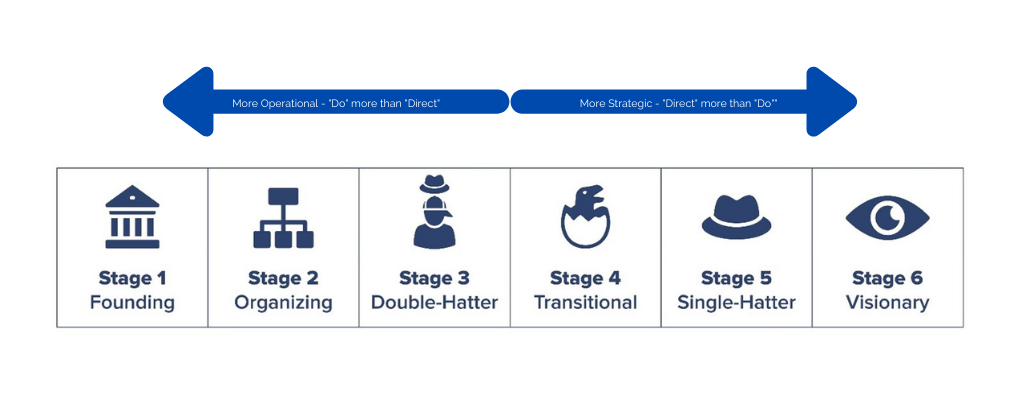As many as half of all associations at the local, state, national, and international level – don’t fit the standard governance model that is treated as “gospel” by governance experts.
Some of the so-called “best practices” in governance are not practiced by a significant number of boards. And, instead of questioning whether such practices apply in all situations, nonprofit governance literature provides a one-size-fits-all approach that implies all boards should be doing such things.
What the literature fails to address is that boards operate at different stages of evolution, largely based on the staff and volunteer resources available to them.
The more operational support a board receives from staff and/or operational committees, the less it is compelled by organizational demands to get into operations. In order to maximize the board’s effectiveness when it is compelled to take on operations, a board must increase its sophistication navigating between operations, governing, and strategic roles.
Where leaders – sometimes within the board itself – tend to make boards wrong is by shaming people/discussions/functions for “getting into the weeds” (i.e., focusing on tasks and organizational minutiae) and “being operational” because a good board should only think “big picture” and “be strategic.” Yet organizational demands when staff and volunteer resources are in short supply may require operational focus from the board.
While staying big picture and focusing less and less on operational detail should be the goal, getting there requires developmental pre-requisites – much as a math student cannot jump from basic addition and subtraction straight to calculus and differential equations. There are several intermediary steps to reaching a higher level of capacity.
Sometimes the board legitimately is not living up to its potential in terms of governing vs. managing and doing vs. directing the work of the organization. In such cases, the board should change its culture.
In many cases, the operations-focused board is right where it should be.
This may be to a greater or lesser extent based on where the board lands among six stages on an evolutionary continuum.
Every board, regardless of how long the organization has been operating, can find itself at any stage on the continuum and can change its stage on the continuum.
Stage 3 Double-Hatter and Stage 4 Transitional Boards represent a sizable percentage of all association boards. Such boards generally lead state and local level associations or may lead small national or international organizations that serve a niche constituency. They tend to have 1-5 full-time staff and may have several operating committees or task forces, but struggle to maintain volunteer “bench strength.”
These mid-stage boards must do a significant amount of the work of the organization because staff and volunteer support are not sufficient for the board to get completely out of operations.
Stage 3 boards are called Double-Hatter Boards because virtually every member wears an operational hat as well as a governing hat. Another term often used to describe this stage is “working” board. In fact, being on one or more committees – or even chairing a committee – may be a requirement of board membership in this stage.
Stage 4 boards are called Transitional Boards because a significant portion of the board engages in operational-level work (double-hatting), while others (the officers most often) focus primarily on strategy and oversight, and do not engage in operational roles. Additionally, some board members may want to get out of operational roles but are currently unable due to an insufficient organizational structure or pool of volunteers beyond the board.
The key point for mid-stage boards is that board members should do their best to only wear their “board hat” in board meetings and their “committee hat” in committee meetings. To that end, the board should have a process for conducting operational work and committee-level decision-making outside of board meetings, so that board meeting time is spent on board-level (fiduciary, governing, strategic), vs. committee-level (operational, task-oriented) discussion.
Change the meeting structure to reduce the operational focus.
A key to supporting board-level discussion is to eliminate verbal committee reports and require written committee reports distributed in advance of the meeting, which are presented as part of a consent agenda. Consent agenda items are materials that are provided in advance for reference and review but are not discussed during the board meeting. The board votes to accept the consent agenda items without further discussion. While this may seem like a small administrative change, it requires a significant change in director mindset to engage this process.
Many governance gurus will say as an absolute that it is the board’s role to govern, not manage. Or, to put it another way, to stay completely out of operations and just create policy, provide fiduciary oversight and strategic direction. My view is – it depends. While all boards should try to do this to the greatest extent possible, a board in the early to middle stages on the continuum may have no choice but to engage in operations, or the full scope of the organization’s work simply will not get done.
Embrace your current stage of development
It is not until a board has evolved beyond Stage 4 Transitional that all board members are capable of fully shedding operational roles (i.e., to remove their second hat). So, if your board falls within the first four stages of the continuum, getting into operations may not only be okay, but necessary.
For now, focus on processes and cultural norms that support optimally navigating the dual roles of “doer” and “director,” and building the organization’s non-board volunteer and/or staff capacity if the board seeks to evolve to the next stages.
For more detail on the 6-Stages of Board Evolution, download the Evolutionary Governance® Handbook, a free resource for association leaders.
About the Author
 Jeff Arnold, MAM, CAE, is CEO of Leading Associations which supports professional associations by bringing a full spectrum of board, management and operational solutions that help them work through challenges that inhibit progress, and grow membership.
Jeff Arnold, MAM, CAE, is CEO of Leading Associations which supports professional associations by bringing a full spectrum of board, management and operational solutions that help them work through challenges that inhibit progress, and grow membership.
Jeff brings a combination of association experience and formal education to Leading Associations’ clients. His present responsibilities include dealing with both the strategic and tactical aspects of running associations. His special areas of expertise include working with boards and committees, certification, training programs, and membership systems. You can reach Jeff on LinkedIn or via email.

